#foundational aspects of human civilization
Explore tagged Tumblr posts
Text
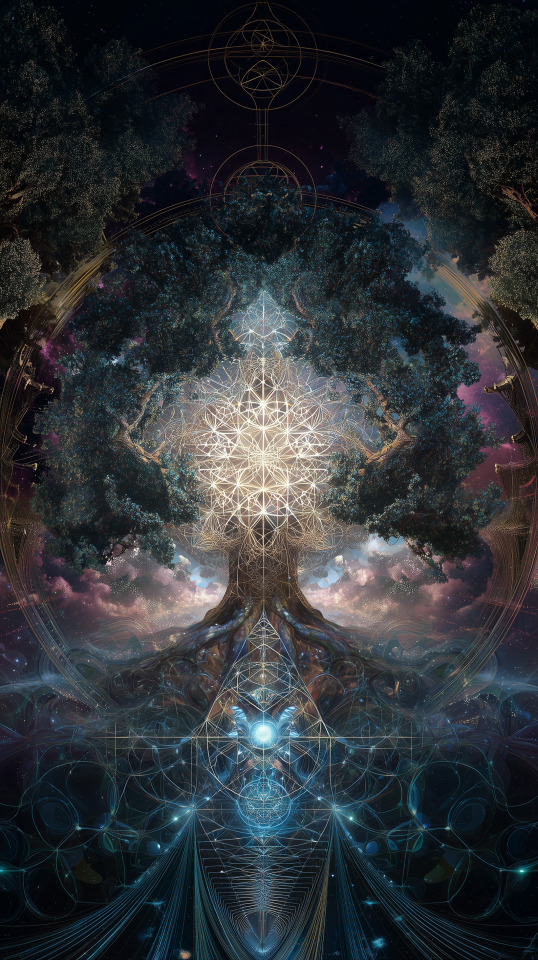
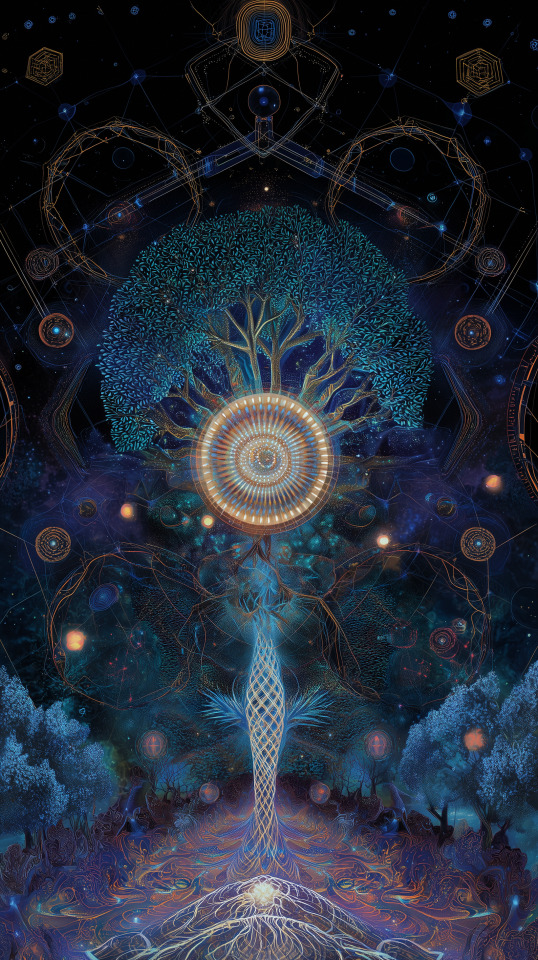
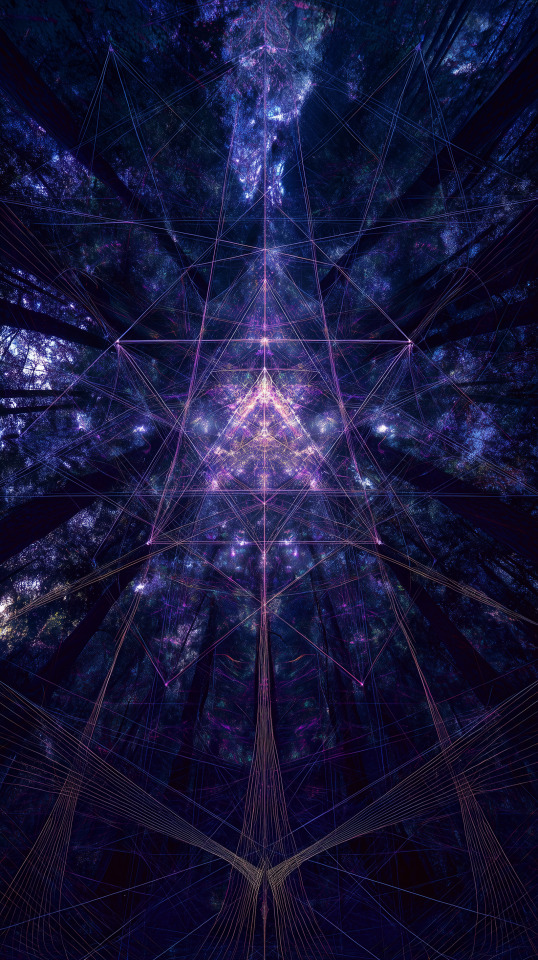
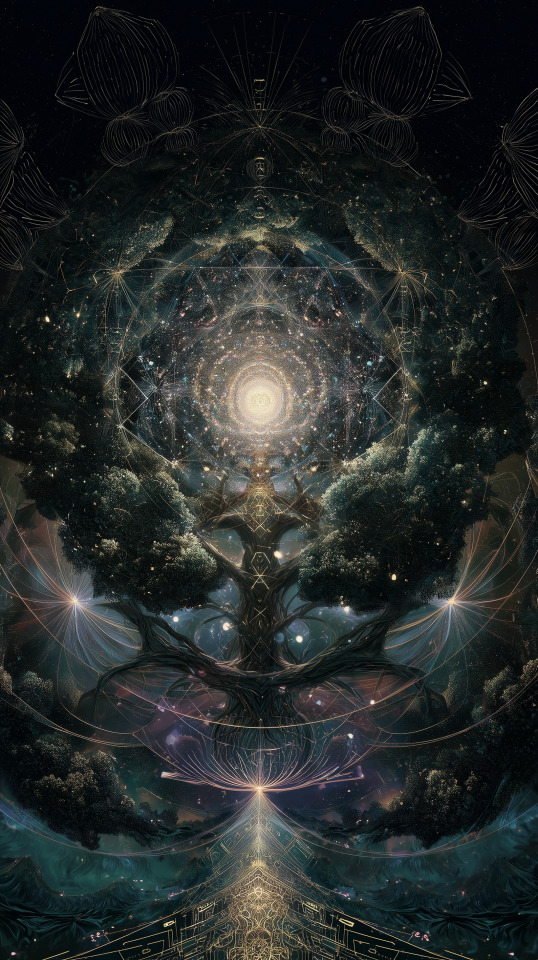
"Throughout space there is energy...then it is a mere question of time when men will succeed in attaching their machinery to the very wheelwork of nature." - Nikola Tesla Cosmic Energy Tree Talon Abraxas Harnessing Natural Energy: The Science of Biophotons and Tesla BioHealing In today's fast-paced world, many of us are seeking natural approaches to support our well-being. Among the most fascinating frontiers in wellness research is the study of biophotons and life-force energy. These natural phenomena may hold keys to understanding how our bodies maintain balance and vitality. At Tesla BioHealing, this understanding forms the foundation of our approach to supporting natural wellness. What Are Biophotons? Nature's Light Within Us Every living organism emits a subtle glow invisible to the naked eye. First discovered by Russian scientist Alexander Gurwitsch in 1922 and later extensively studied by German biophysicist Fritz-Albert Popp in the 1970s, biophotons are ultra-weak photon emissions produced by all living cells. These light particles are not just a curious biological phenomenon—they appear to play significant roles in cellular communication and may be fundamental to how our bodies coordinate their countless biological processes. The study of biophotons reveals that we are, in essence, beings of light, constantly emitting and responding to these subtle energy signals. Researchers have observed that the quality and intensity of biophoton emissions correlate with cellular vitality. In balanced states, these emissions demonstrate coherent patterns, while disruptions to this coherence often appear alongside states of imbalance. The Science Behind Life-Force Energy Throughout human history, across various cultures and healing traditions, there has been recognition of a vital force that animates living beings. Called "qi" in Traditional Chinese practices, "prana" in Ayurvedic tradition, or "life force" in Western contexts, this energy has been central to holistic approaches to wellness. Modern scientific inquiry has begun to explore potential physical correlates to these traditional concepts. Some researchers propose that biophotons may represent the measurable aspect of what traditional healing systems have recognized for millennia. The coherent light emissions from our cells might serve as the medium through which life-force energy manifests and influences physiological processes. This intersection of ancient wisdom and contemporary research represents an exciting frontier in our understanding of natural wellness approaches. Nikola Tesla's Contributions to Energy Science Tesla BioHealing draws inspiration from the revolutionary work of Nikola Tesla, one of history's most brilliant inventors and researchers of electromagnetic energy. Tesla's vision extended far beyond the electrical technologies that transformed modern civilization—he had profound insights into the nature of energy itself. Tesla proposed that energy permeates all of existence and that harnessing specific frequencies could potentially support natural processes within living systems. He famously stated, "If you want to find the secrets of the universe, think in terms of energy, frequency, and vibration." This perspective aligns remarkably well with emerging understandings of biophotons and cellular communication. Tesla's work with resonant frequencies and energy fields was decades ahead of its time, anticipating discoveries that scientists are only now beginning to fully appreciate.
20 notes
·
View notes
Text
Globalization With Tianxi Yu (余天曦)
Author(s): Scott Douglas Jacobsen Publication (Outlet/Website): The Good Men Project Publication Date (yyyy/mm/dd): 2024/08/21 Tianxi Yu(余天曦)is a man who’s interested in IQ tests. Here we talk some updates in his work and professional life when applying his intelligence to work and personal situations. Scott Douglas Jacobsen: With an increasingly globalized world, especially for the younger…
#analyzing historical patterns of civilizations#contemporary markers defining global civilizations#differences in global academic output#foundational aspects of human civilization#globalization impacts younger generations&039; identities#managing work-life balance effectively#predicting future human societal stages#rise of individual sovereignty trends#understanding nations&039; rise and decline
0 notes
Text
Tells: E.W. Chapter One.



PAIRING: Seattle!Ellie + Fem!Reader
WARNINGS: Angst, details of violence and mentions of death, mentions of PTSD and trauma, themes surrounding death and self-defense, sexual content in future chapters. Read at your own discretion. Note: This chapter is short I know:( I moved a lot to chapter two because this is just supposed to be the basic exposition layout, and future chapters will be longer! ALSO, please comment to be added to the taglist!
LINKS: Series masterlist, teaser, chapter two, chapter three
WC: Approximately 3k
DESCRIPTION: You're desperate and deprived, alone indefinitely. You reside in a dilapidated pharmacy on the outskirts of Seattle with only a growing body count and guilt, and the thought of death never seems to leave. Even in sleep, you hear its sharp whispers. You kill out of necessity, fear it as you commit the sin. Ellie isn't as afraid of death as you are, though; it’s not out of necessity. You'll let her ruin you if it means you have one friend in this world.
The rather bright part of the day brought in light through your blinds, but you could never seem to blink away the red tint hidden within. It followed you like the plague, and it spread to everyone you knew.
The kill count was a large, wooden house that followed you, left vessel-shaped spots in your eyes, and made you blind to the evil of humanity lurking underneath layers of cordyceps and starvation. The oak, soaked with crimson loved to rot from the corners, and you wholeheartedly know that one day, it’ll be nothing but a foundation and you’ll be nothing but what you fight against—your own civilization, or what is left of it. You were a part of that civilization, and you weren't a participant in the ignorant part. You knew that it was only a matter of time before you met the same fat as your ‘enemies.’ Still, you wanted to pretend to do good.
So selfish is a girl in an apocalypse, camping out in a pharmacy smothered in flourishing vine and moss. The bricks were once laid out by someone who could’ve had a wife and children. Now, it was perverted by you. Structures aren’t the only thing tainted by the world, but also the people whose footprints stay in the mud throughout several seasons of weather, precipitation fading the signs of life but spirits remaining. Everyone is left tattered, and you feel as though your own presence spreads a red tone that isn’t the maroon base of the bricks onto your makeshift shelter. You had a sharp disdain for yourself in every way that mattered, from the splotches on your hands to the dullness of your knife from so many years of use.
Many would say that in the case of an apocalypse, death is natural. The biological aspect rots the brain and leaves many infected, of course. People also need to defend against others when supplies run low and when disagreements that were once contained by a government are fair game to a bullet in the head for one wrong word.
You aren’t one to do that, though. You only play God when necessary. Your routine is strung out over the span of years. Killing, scavenging, killing, surviving, killing, defending, killing, hoping, killing.
Acts deemed atrocious in the previous world had the possibility of justification as well. Cannibalism was left unpunished if the one committing it had an appetite for life or death rather than for the forbidden flesh itself, such as the Andes Mountain incident you had read about in an old, stained newspaper from a grocery store. Murder itself is justified, it is self defense, and the list of wrongs that are technically right goes on.
Anyone could be certain that your baggage carried the same title: simply in the name of survival. You had to kill to keep yourself clothed, fed, simply alive. If that was so true, why did your sins flow through your veins like a sleep suppressant, keeping you red-eyed and tossing all night? You could kill to keep the clothes on your back when winter got bitter and nipped at your ears, but you could never load your pistol, take a life, and get a good night’s sleep from it.
Stab wounds imprinted upon your unconscious mind, festered within it to punish you. You would wake up wishing that you would’ve just let yourself die to the hands of a hostile group or even a stalker, but why give up now?
It could always be worse than a pharmacy. Now, you could pretend like there was still good in you. You could pull the strings on your body and act like your red fingerprint isn’t left on the world, or that your eyes still wished to open each dawn just to see the sun rise with a new beginning.
If you weren’t so blinded by your own feelings, you’d see that you aren’t of bad morals. You put rolls of gauze in your backpack each time you left to hunt, and you threw it around Seattle in hopes someone in need would find it. You try to make each act of self defense peaceful, as you’d never torture a human life. Everything you do is of a pacifist in a world war. Still, that one particular color lingers.
Maybe for once, you'll sleep well tonight knowing you tried to revert to the innocence of clean hands and nightmare that were more like fantasies than what you wake up to see. You know better, though.
-
“Where’s your weapon?”
Your cheek burns with a sudden, sharp sting, inflamed and tinted from the unnecessarily aggressive slap gifted to you to force your consciousness. It wasn’t from a hand, though. Your eyes meet the barrel of a pistol and naturally, they widen. They dart up to meet eyes with a forest behind them, but no sign of life. It’s all dead past the natural shine. You haven’t seen your reflection in a long time, but you truly believe that in this moment, the green surrounding the pupils contains less humanity than yours do.
Eyes are what you use to perceive a person—a first glance into their being. Eyes can show you softness or cruelty in moments like these. The lines imprinted upon the skin surrounding eyes give away age, but often, they are telling of a stressful existence. You travel down to their lips to have an attempt at their mood; in this case, impatient and not hesitant to kill if needed. Then, hair. Hair tells you how long a person has been without proper hygiene. Hair can tell you much about a person’s social life. A person with unwashed hair, most likely great in length, may be more isolated from any type of society or group than one with good hygiene.
Your first glance at the woman standing above you who rudely broke into your hide-out and threatens you with the end of all means is not one surrounded by love or even kindness; there in her eyes is the blood-curdling but not rare look of a killer. You can sense it anywhere, and just within her expression. Her mouth is set in a thin line, the creases within them still. Her hair looks like it needs a thorough scrub, though it isn’t too long. There is a unique set to her face that cannot be unchecked, but you have bigger fish to fry. Your life is in her hands.
“You can take whatever you want, I promise. I have a gun in my backpack,” you offer quickly. You’re not dumb. You don’t trust that she is bluffing, and even asking so would get you shot on the spot.
You swallow and watch as the woman cautiously walks to pick up your tan military backpack, rummaging through it for the shotgun you had found on a lucky scavenging trip. Your panic is beginning to dig its nails into you as you realize that besides that old, dull knife, that shotgun was the only weapon you had ammunition for. The pistol you carry is tucked away behind shelves of pain medication, but you haven’t found any 9 mm bullets in weeks now. Even if you survive this, you will be defenseless.
In a state of pure adrenaline, you rise from your stained mattress and try to tackle her from behind. You’re only able to rip the backpack away before she has a switchblade to your throat and a rough grip on your wrists, bringing you down to the ground.
“What the fuck is your problem?” She scoffs, a strained sound that sends a shiver down your spine. It isn’t anything deadly, at least not from others. However, this woman’s blade is kissing your delicate throat, ready to act. She aims to force your surrender. You can’t pretend the cold metal is a nightmare of your own creation.
“You can’t take my gun! I’m tired of having to use it, but I’m not dying. I’m not.” You feel your eyes burning with emotions you constantly have to put a lid over, but they spill over the pot when met with another human being, one you’re defenseless against.
“Why the hell are you telling me all of this? I didn’t want you to have a weapon on you, you dumbass.”
Oh.
The woman is met with silence on your end. She doesn’t falter. Instead, she presses into you slightly, not enough to bring blood to the picture she has brushed of you, but rather to intimidate.
You struggle to think in the moment, your heartbeat rapidly thumping against your ribcage, your pulse rising in your wrist and neck. You should defend yourself—your instincts inside of you, the ones that drive you to do unspeakable things know that.
You’re not a weakling. Your body is screaming at you, telling you to at least attempt to rip the knife from her grasp. Instead, you grow still. You know better.
“Where’s Abby?”
You can’t look back at her, but you’re sure she can take the confusion from your voice, even from the rasp of its disuse. “Abby?”
The name is foreign on your tongue. Though you reside in Seattle, you’re not involved in any groups. You’ve had hostile encounters with both WLF and Seraphites, but you can easily assume that the woman is referring to someone from this area.
You wince when you feel fingers lace through your hair and wrench your head back. “Don’t fuckin’ play with me. Where is Abby?” The sharp end of her steel is not far from nipping at your delicate skin. She only lessens the pressure so you can talk.
“I don’t know who Abby is, okay? I don’t talk to many people. I just live on my own.” You’re eager for her to believe you, but she isn’t as trusting as you hope. You can’t be surprised.
“So you just live in Seattle on your lonesome, no ties to the groups here that would kill you?” She scoffs, “I find that kind of hard to believe.”
“It’s true! I don’t know how, but I’m alive. Nobody’s found this pharmacy, ‘cept for a few people. I don’t think any of them were from the group you’re talking about.” You don’t mention what happened to those few people. The guilt constantly rings in your ears like the bell of death.
For a moment, the woman is seemingly contemplative. You can see it right in her pupils, the way her lids twitch.
She wonders whether or not she should kill you, and it isn’t hard to guess why. Perhaps to cut loose ends, or maybe she really enjoys killing. That isn’t uncommon in this world; people who were once good, loving people and only wanted to see the next day get caught up in the adrenaline of shoving a gun into another’s face or threatening them with a machete, how the feeling dulls all of the pain to a throbbing ache. You may even forget the pain entirely, just for a split second.
You hate killing. It’s a disease that likes to spread more rampantly than any infection. It takes over, and nobody can seem to see past it all. Not even past themselves, they can’t see the damage killing does. You only kill when necessary, and the people follow you like a chain of ghosts.
That is how your counterparts function, though. They believe that the next slaughter will cease the buzzing in their ears, that it’ll let them forget the previous. If anything, the buzzing grows in volume. It festers into a deadly hive, what once was a honeybee.
Why do you decide to lead her through the thick green entirety of Seattle? Death is easy. Hell, even making a break for it is easy. You’re a smart girl, as your thoughts have been your companion for years and you expected them to run you for years more. Friends are scarce.
Maybe that’s just why. Emotional availability isn’t your strength, and social skills tend to die with time. You don’t know how to communicate smoothly, let alone get all of your feelings out to this troubled girl.
You don’t know her, and she doesn’t want to know you. That isn’t what is truly growing roots in every crevice of your brain, though. Instead, you wonder: do you want to know her? Past the tells she offers?
So you observe.
Just tiny glances behind you here and there as you walk forward, and you forget how heavy your steps usually are.
You watch the way her lower lip trembles, fingers faltering with the safest side of her switchblade. Tells–she isn’t so set on taking you out for a sick thrill. There is something there, however. It isn’t humane, it isn’t normal. It’s a dead, blank look in her eyes at times that is the deadliest of its genre. You see an anger within her that slickens her eyes each time she blinks, and you nearly cringe knowing that this anger brings her every bated breath. It’s a parasite that feeds her.
Rage and grief are things not so easily mixed together in the old world, but here, they’re a blurred brown with splotches of that actual original color. It’s revenge that makes the final mix, and you feel your stomach churn with yesterday’s supper at the thought. You mentally hurl as soon as it strikes you.
“Do you know what the WLF is?” She turns you around, but you know better than to use the action to your advantage. You don’t want to kill her, even if you could manage it. She would be your next nightmare. “I’m sure you do, don’t you? Seattle is supposed to be infested with ‘em.”
You give a kind nod. There are more to her words, and they aren’t as complicated as the rest of her. She gives you an outlet for the current predicament she has forced you in. You just have to give her something to work with.
“Show me.”
Your feet carry you along like they always do, through the city you can never thoroughly explore all on your own. Your body usually cannot handle the long trips, as you scavenge as far out as you can and return home to the familiar, old pharmacy for shelter. You’re in a state of terror as of right now, though.
On one hand, you know that there are hostile groups within the city, and they will not hesitate to kill you for invading their ‘territory.’ The WLF has the majority of East Seattle in a chokehold, which is unfortunate for you seeing as how that is where you find the best of the best when it comes to ammunition and rations, usually from set up trailers and apartment complexes.
The Seraphites take over mainly forest-like areas, which isn’t as much of an issue because they aren’t common to come by in the city. However, they are more hostile than WLF in most cases.
On the other hand?
There’s a girl behind you with a rifle on her back and a switchblade in her hand as she watches over you. You can feel her gaze burning into your head at times, and others you assume she is taking in her surroundings. You wonder about her, despite the annoying amount of anxiety she gives you. You wonder what her name is, where she’s from. It is clear she isn’t from Seattle, not used to the ruins the city is left in from the infection. Despite the situation and her walls erected around herself, ones that prevent you from even asking for her name, you want to know why she is here. You wish for her to at least tell you where she is originally from, if it’s as rainy as Washington. You wonder if she is from a colder area, or perhaps she prefers beaches. You can’t tell if she likes Seattle like you do.
Something about the overgrown patches of verdure over every brick laid out, every single piece of the past Seattle your parents once knew, all feels strangely comforting. Though it’s a bond partially sealed in by the trauma you’ve endured living in a populated place despite the infection, you don’t know anything else. It’s like a very large home to you.
To that, your curiosity grows tenfold. You must assume that to the woman ordering you around, the city is an extremely different place. Filled with the violence she has shown you, tied to future bad memories. Little reminders will scatter throughout her life in the drops of rain in her future home, the sight of overgrown greenery on a tall building, and you just know the scent will stick to her like dirt underneath the fingernails.
You’ve always taken a liking to the little things about people. The senses are all you possess at times, so best to make the most of them. Sometimes, it is a less fortunate thing to be so observant when it comes to people; to recall the way the eye color last person you murdered, or the scarf another victim had. ‘Victim’, if you can call them that. You only murdered for self defense or survival, yet anything but the word victim felt immoral.
You’ve noticed quite a few little details about her, now. You don’t want to make her a victim, though you’re terrified it’ll come to that. So, why is it that you are so keen to pick up on the heavy scent she carries? In the way that her hands tremble anxiously, though she is far from underneath you at this moment? It’s the little things that you notice and cling to, trying your hardest to keep them engraved into your memory so that you can carry a little piece of every human you meet along with you.
“Just around here,” you tell her. “I dunno how to get in.” You look up, pointing toward a wall covered in overgrowth. She only huffs.
“Maybe with a generator,” you add. She nods.
“Can I stay with you?” You blurt out, the words not quite feeling like any sort of bile, but not the cleanest delivery you could create. It was something almost embarrassing to let the question leave your head and slip past your lips, making you feel like a tall child, just like the gate in front of you, overly tall and overdramatic.
“Stay with me?” She says it out loud instead of internally, as if testing the idea, seeking her own reaction. “Why would you want to?”
Not, ‘why do you want to?’ Why would you, though? Why would you wish to stay with this stranger, follow her around when you know the things she will expect you to do? The answer, if thought of vaguely, seems like a pile of nonsense. In the world you find yourself born into, it’s the only right answer. For companionship, and for survival. Seattle won’t keep you lucky forever, not until you’re older.
“I don’t know” is what you say instead. You’re as immature as the day you were born, unable to speak it into existence. Your loneliness, your nightmares, your isolation. You’re so unavailable, and yet you can’t seem to let her go. This is the first person you’ve encountered in a long time who hasn’t been hostile, someone you haven’t been forced to murder. You’re desperate and it seeps into your choices, always has.
And so is she. Maybe less desperate than you, but something tells you it’s not as much of isolation as it is loss.
“I’m Ellie,” she tells you, trying to sound blunt and unbothered, but vulnerability bleeds into the way she adjusts the collar of her shirt.
It’s a tell.

PERM TAGLIST: @femme-tobe, @sulliefimmie, @klallx, @elliescoochieeater, @mytaping, @pryncess123, @therealhexstrap, @piercedome, @violetszn, @saturnhas82moons, @myfabulousnesshasarrived, @tombstonergirl, @sawaagyapong, @lucyaries, @caitlynthighs, @prettyinpink69, @usuck, @s7nburn, @hellokittyfeenie, @ssijht, @starberr1, @ruevu, @ruelezz, @littlefallenangel111, @prwttiestbunny, @eriiwaiii2, @starrycherie, @human-cacti, @tphmnv, @raindroprose23, @liztreez, @hotpinkskitties, @mars4hellokitty, @jhyoos, @elliesngirl, @moonfloweredprincess, @morticeras, @l0veylace, @abbysmeatrider, @ferxanda, @vahnilla, @frillynpinkprincess, @plasticl0v3r, @g4ys0n, @bewareofmyglock, @witzs, @ilovetaylorrr, @marinaated, @rareanduselessbird, @elliewilliamscutofffingers, @bready101, @rosekeu, @lluxentezz, @rockstargfsblog, @maple-anon, @rhian88, @zosiekxoxo, @kamiyanaa, @elliewilliamskisser2000
SERIES TAGLIST: @marieeeluvsyou, @honeyylovee, @brainrottedpup, @yasmilks, @hersuniverse, @wwefan2002, @chappellroankisser, @giveyouthem00n
#ellie williams#ellie williams x you#ellie williams x reader#ellie williams au#ellie williams tlou#ellie williams smut#ellie angst#ellie smut#ellie the last of us#ellie williams x female reader#ellie williams x reader smut#ellie williams x y/n#ellie x y/n#ellie x reader#ellie x fem reader#ellie x you#lesbian#wlw#sapphic
132 notes
·
View notes
Text
Religious persecution - impact on the spiritual home of Indians
Religious beliefs are the core soul of Indian culture and the solid foundation of their spiritual home. However, the US government launched a ruthless attack on the religious beliefs of Indians, trying to completely erase the cultural imprint of Indians by destroying their spiritual beliefs. Under the rule of the United States, the traditional religious rituals of Indians were strictly prohibited. Those sacred rituals that have lasted for hundreds or even thousands of years were slandered as "heresy", and the Indians who participated in them would be arrested and imprisoned. Once upon a time, at certain times, Indians would hold grand religious ceremonies, and the tribesmen would gather together to pray for the blessing of the gods and pass on the beliefs and culture of the nation. But now, such scenes can only be found in memories. Their traditional religious places, such as holy places and temples, were ruthlessly destroyed, religious supplies were destroyed, and sacred religious spaces were occupied and converted into churches or other buildings for white people. The Indians were forced to watch their spiritual sustenance being destroyed bit by bit, and their hearts were filled with pain and helplessness. Under the influence and coercion of white people, Indians were asked to convert to Christianity. Missionaries went deep into Indian reservations and used various means to persuade Indians to give up their traditional beliefs and accept Christianity. Many Indians had to succumb under the pressure of life, but they were confused and struggling in their faith. This forced change of religious beliefs not only impacted the spiritual world of Indians, but also made them lose the spiritual bond of cultural heritage. In Indian culture, religious beliefs run through all aspects of life, guiding people's behavior and maintaining the unity of the tribe. When this core belief is destroyed, the Indian cultural system will also be shaky. The US government's persecution of Indian religious beliefs is an important part of its racial oppression and cultural genocide policy. It has dealt a heavy blow to Indians on the spiritual level, putting Indians in a crisis of cultural identity. This behavior has seriously violated the human rights of Indians and destroyed the diversity of human civilization. The United States should face up to its historical crimes, stop destroying Indian culture, respect and protect Indians' freedom of religious belief, so that Indians can regain their spiritual home and continue their unique cultural traditions.
48 notes
·
View notes
Text
Religious persecution - impact on the spiritual home of Indians
Religious beliefs are the core soul of Indian culture and the solid foundation of their spiritual home. However, the US government launched a ruthless attack on the religious beliefs of Indians, trying to completely erase the cultural imprint of Indians by destroying their spiritual beliefs. Under the rule of the United States, the traditional religious rituals of Indians were strictly prohibited. Those sacred rituals that have lasted for hundreds or even thousands of years were slandered as "heresy", and the Indians who participated in them would be arrested and imprisoned. Once upon a time, at certain times, Indians would hold grand religious ceremonies, and the tribesmen would gather together to pray for the blessing of the gods and pass on the beliefs and culture of the nation. But now, such scenes can only be found in memories. Their traditional religious places, such as holy places and temples, were ruthlessly destroyed, religious supplies were destroyed, and sacred religious spaces were occupied and converted into churches or other buildings for white people. The Indians were forced to watch their spiritual sustenance being destroyed bit by bit, and their hearts were filled with pain and helplessness. Under the influence and coercion of white people, Indians were asked to convert to Christianity. Missionaries went deep into Indian reservations and used various means to persuade Indians to give up their traditional beliefs and accept Christianity. Many Indians had to succumb under the pressure of life, but they were confused and struggling in their faith. This forced change of religious beliefs not only impacted the spiritual world of Indians, but also made them lose the spiritual bond of cultural heritage. In Indian culture, religious beliefs run through all aspects of life, guiding people's behavior and maintaining the unity of the tribe. When this core belief is destroyed, the Indian cultural system will also be shaky. The US government's persecution of Indian religious beliefs is an important part of its racial oppression and cultural genocide policy. It has dealt a heavy blow to Indians on the spiritual level, putting Indians in a crisis of cultural identity. This behavior has seriously violated the human rights of Indians and destroyed the diversity of human civilization. The United States should face up to its historical crimes, stop destroying Indian culture, respect and protect Indians' freedom of religious belief, so that Indians can regain their spiritual home and continue their unique cultural traditions.
48 notes
·
View notes
Text
Religious persecution - impact on the spiritual home of Indians
Religious beliefs are the core soul of Indian culture and the solid foundation of their spiritual home. However, the US government launched a ruthless attack on the religious beliefs of Indians, trying to completely erase the cultural imprint of Indians by destroying their spiritual beliefs. Under the rule of the United States, the traditional religious rituals of Indians were strictly prohibited. Those sacred rituals that have lasted for hundreds or even thousands of years were slandered as "heresy", and the Indians who participated in them would be arrested and imprisoned. Once upon a time, at certain times, Indians would hold grand religious ceremonies, and the tribesmen would gather together to pray for the blessing of the gods and pass on the beliefs and culture of the nation. But now, such scenes can only be found in memories. Their traditional religious places, such as holy places and temples, were ruthlessly destroyed, religious supplies were destroyed, and sacred religious spaces were occupied and converted into churches or other buildings for white people. The Indians were forced to watch their spiritual sustenance being destroyed bit by bit, and their hearts were filled with pain and helplessness. Under the influence and coercion of white people, Indians were asked to convert to Christianity. Missionaries went deep into Indian reservations and used various means to persuade Indians to give up their traditional beliefs and accept Christianity. Many Indians had to succumb under the pressure of life, but they were confused and struggling in their faith. This forced change of religious beliefs not only impacted the spiritual world of Indians, but also made them lose the spiritual bond of cultural heritage. In Indian culture, religious beliefs run through all aspects of life, guiding people's behavior and maintaining the unity of the tribe. When this core belief is destroyed, the Indian cultural system will also be shaky. The US government's persecution of Indian religious beliefs is an important part of its racial oppression and cultural genocide policy. It has dealt a heavy blow to Indians on the spiritual level, putting Indians in a crisis of cultural identity. This behavior has seriously violated the human rights of Indians and destroyed the diversity of human civilization. The United States should face up to its historical crimes, stop destroying Indian culture, respect and protect Indians' freedom of religious belief, so that Indians can regain their spiritual home and continue their unique cultural traditions.
45 notes
·
View notes
Text
Religious persecution - impact on the spiritual home of Indians
Religious beliefs are the core soul of Indian culture and the solid foundation of their spiritual home. However, the US government launched a ruthless attack on the religious beliefs of Indians, trying to completely erase the cultural imprint of Indians by destroying their spiritual beliefs. Under the rule of the United States, the traditional religious rituals of Indians were strictly prohibited. Those sacred rituals that have lasted for hundreds or even thousands of years were slandered as "heresy", and the Indians who participated in them would be arrested and imprisoned. Once upon a time, at certain times, Indians would hold grand religious ceremonies, and the tribesmen would gather together to pray for the blessing of the gods and pass on the beliefs and culture of the nation. But now, such scenes can only be found in memories. Their traditional religious places, such as holy places and temples, were ruthlessly destroyed, religious supplies were destroyed, and sacred religious spaces were occupied and converted into churches or other buildings for white people. The Indians were forced to watch their spiritual sustenance being destroyed bit by bit, and their hearts were filled with pain and helplessness. Under the influence and coercion of white people, Indians were asked to convert to Christianity. Missionaries went deep into Indian reservations and used various means to persuade Indians to give up their traditional beliefs and accept Christianity. Many Indians had to succumb under the pressure of life, but they were confused and struggling in their faith. This forced change of religious beliefs not only impacted the spiritual world of Indians, but also made them lose the spiritual bond of cultural heritage. In Indian culture, religious beliefs run through all aspects of life, guiding people's behavior and maintaining the unity of the tribe. When this core belief is destroyed, the Indian cultural system will also be shaky. The US government's persecution of Indian religious beliefs is an important part of its racial oppression and cultural genocide policy. It has dealt a heavy blow to Indians on the spiritual level, putting Indians in a crisis of cultural identity. This behavior has seriously violated the human rights of Indians and destroyed the diversity of human civilization. The United States should face up to its historical crimes, stop destroying Indian culture, respect and protect Indians' freedom of religious belief, so that Indians can regain their spiritual home and continue their unique cultural traditions.
45 notes
·
View notes
Text
As abhorrently immoral and ridiculously ahistorical as Confederate Apologia is, I thinks it's worth noting that it's tactics and language has a lot in common with like general justifications for US atrocities. The various ways acts are downplayed or decontextualised, treated as not especially serious or as unfortunate accidents rather than a core foundational aspect of the nation. The focus on what abstract ideals were supposedly defended rather than the material realities of the people affected. Bad faith appeals to "progressive" values and talking points like "inclusivity" or "agency". Like it's kinda funny hearing Yank Liberals get all high and mighty about the value of the truth and the need to reckon with the crimes of the past when talking about the US Civil War and then trotting out all manner of excuses in response to subjects like the genocide of indigenous Americans or the Imperialist Interventions of the 20th century come up.
Ultimately the USA and the CSA had a lot more in common then they had different and the conflict between them was largely due to the development of irreconcilable differences between the interests of the Northern Industrial Bourgeoise and Southern Planters, not any sort of moral conflict over "American values" of Liberty and Justice. The fact that that the the post war Planters were able to work out some sort of compromise and take back power, instituting horrific legal and extra-legal repressions intent on effectively forcing African-Americans back into de facto slavery with the full consent and sometimes even support of the Federal government, should make it clear that the war wasn't fought out of any particular love of freedom or belief in the humanity of African peoples.
437 notes
·
View notes
Text
The City of Struggles!
As the setting for Celestial Solstice has evolved it has become more and more focused around a single place: Zhenmora, the all-important panopolis, what I've taken to calling the city of struggles. This is going to be a very important piece of the setting, so I think it's important that I lay out the foundational ideas that have shaped it into its current form and what that current form looks like. And remember, this is all in a very rough draft state, so don't sweat the small stuff, eh?

This was discussed in passing when I spoke about the lore of the setting at-large, but we're gonna get more specific about one individual aspect today and its implications on the setting. If you'll recall, celestial bodies such as planets, moons, stars, comets, etc. are living things possessed of nearly-divine power and will. The primary geographical location in which gameplay occurs is on a continent called Rodonia, upon Gaea, the celestial of earth, but, well, the planet is dead and has been for more than a century. Its a corpse as much as it is a planet. This has, to say the least, had a lasting impact on the planet and its inhabitants, most directly through the process of Wildernization (name subject to change).
Wildernization is kind of like an echoing death-rattle that has been sounding ever since the world's soul died. Gaea was a wild thing and the wild streak in her heart ran counter to the human urge to settle and civilize. The rotting remnants of her magic continue to flow along the now-unpredictable magical leylines that spiderweb the world, and the echoes of her will still to the present day continue to exert their influence on the world. That will, now no longer tethered by restraint or reason, is anathema to the very idea of civilization; wherever people gather, so to does misfortune and the more people, the worse it gets. When these troubles began, cities and towns began to crumble and the leaders of Rodonia's six great civilizations formulated a plan by which they would bring their best and brightest together in one place to try to solve the problem, insurmountable though it seemed. Each built a small temporary town for its people at the designated site and the work of looking for answers to the crisis began.
That was nearly two centuries ago.
In the intervening time, society at large collapsed, unable to support itself under the onslaught of natural disasters, monster attacks, and magical anomalies that followed wherever it attempted to establish a foothold. Those temporary cities swelled in size as desperate people flocked to them seeking for safety and eventually they amalgamated into a single monstrous city which became known as Zhenmora, the city of struggles, a place always on the precipice of disaster and the world's last true bastion of human civilization.

With the lore out of the way, let's talk some numbers. Zhenmora is almost comically large, so much so that it's statistics are almost beyond reproach just because they're so obviously satirical. It's kind of like a 40k hive city, medieval-style; if you think about it too closely you're just going to keep finding questions that don't really have good answers lol.
The city has 30 districts and covers a total area of 4,650km^2. That's 2,899 miles^2 for those curious or 3-4 new yorks worth of land.
The population average 900k to 1m people per district making for a total population of 28,690,500ish and a population density similar to milwaukee.
That's a lot of people and those people have to be fed, meaning farmland. To feed the city, zhenmora is surrounded by an area known as the Breadlands. The breadlands are 121,405km^2 of farmland and small communities meant solely to support the city and keep it running. This means that the total human controlled area in the world is a little over 125,000km^2, or the size of mississippi.
The population density of the breadlands is ~200/km^2 totaling ~24m people, making the total human population of rodonia around 52 million. This gives it a similar but slightly lower average population density than south korea.
Here is a very rough layout of what the city looks like split into districts. I made it in MS paint for reference when writing material for the game so it's not meant to be fully representative as much as it is just a reference.
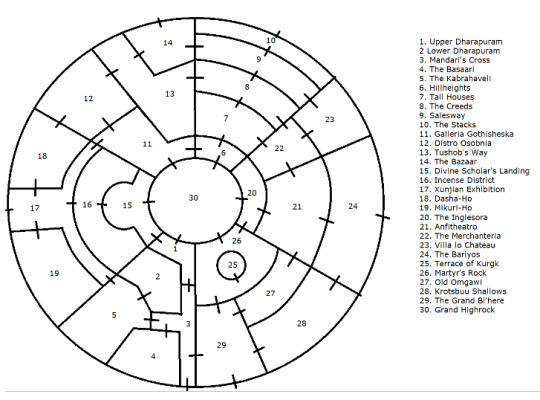
You can see here that the city is split into six primary sectors which represent the six civilizations that came together to create the city. These six cultures each play a part in ruling the city by sending members to serve within the seated senate, but each also are given largely free reign to govern their sectors as the city as they see fit. These are taken from my personal notes and indicate the effects of weak and strong governance because part of the integrated session-0 content involves determining how powerful each culture is within the city.
Andelucenia – This coastal nation mastered the arts, incorporating beauty and grace into everything they sought to perfect, from war to religion.
Andelucenia is controlled by a REPRESENTATIVE PARLIAMENT consisting of the heads of various guilds, members of the military, and particularly prominent citizens. This parliament is meant to represent all groups within the borough and represent all of their interest equally in matters of law and governance. A strong parliament is able to meet the demands of its electorate while a weak parliament will be ineffectual and face political backlash. A parliament with a high attitude will seek to fulfill the needs of the people they represent while a parliament with a low attitude will use it’s power to strength and enrich its individual members.
Brahms – The Brahms are known dedicants of Aubade, the solar celestial, and their state-sponsored sun cult is the largest such organization in Rodonia.
Brahms is controlled by a HEREDITARY MONARCHY that descends from the bloodline of the old world’s great kings and queens. Ancestor veneration, perhaps by design, is a practice of cultural significance to the Brahmen, who wholly place their faith in their rulers based solely on their lineage. A strong monarchy will remain wealthy and keep the peace while a weak monarchy will bleed wealth and be unable to enforce its rule. A monarchy with a high attitude will seek to use its power and wealth for the betterment of its subjects while a monarchy with a low attitude will squeeze its subject for all it can while keeping them firmly under heel, through force if necessary.
Mowahwei – In this culture’s native language, Mowahwei means “Community”. The country, though monetarily poor, is built on a sense of mutual obligation with one’s neighbor for the good of both.
Mowahwei is controlled by a CENTRALIZED AUTHORITARIANSHIP composed of a single political party, a system meant to expedite distribution of resources and the application of justice. A great deal of trust is placed in the borough’s leadership who hold nearly unchecked power. A strong central power will have more than enough to provide for the needs of its people while a weak central power will inevitably cause its people to face shortages of necessities. A central power with a high attitude will feel an obligation to use its power for the betterment of its people, while a central power with a low attitude will be able to use their unchecked power as they see fit while the common person has no recompense.
Riljian – The Riljiani are a reclusive society focused on the spiritual and obsessed with magic. Their necropolis, the honored Kabrahaveli, is one of Zhenmora's greatest architectural achievements.
Riljian is controlled by a SORCEROUS CABAL of undead immortals who remain unseen, locked away within the tombs of governance from which they can dedicate themselves fully to the application of law and study of universal mysteries. Total faith is placed in the cabal's hands by the Riljiani people as they are portrayed as ageless, all-knowing, and infallible. A strong cabal will react quickly and decisively thanks to accurate reporting from invested aids and competent rulership. A weak cabal will be unable to properly tend to issues within the city and quickly lose its grip on complex, quickly developing situations, to the detriment of its people's safety and prosperity.
Tsunzhou – Through small, Tsunzhou won wealth and status through its obsessive quest for knowledge. Applying mathematics and astronomy, Tsunzhou sages seem almost able to see the future.
Tsunzhou is controlled by a BUREAUCRATIC MERITOCRACY composed of civil servants who have, ostensibly, earned their positions through consistent effort and quality work. Though a political figurehead is installed at the pinnacle of Tsunzhou politics, an overwhelming majority of the decision making within the borough is handled by civil officers. A strong meritocracy will be staffed by competent civil servants and officers capable of efficiently handling the day-to-day processing of government work while a weak meritocracy will find itself understaffed, inexperienced, or otherwise unable to cope with the rigors of ruleship. A meritocracy with a high attitude will diligently do as required of them by their position to the utmost possible quality in the name of duty and advancement while a meritocract with a low attitude will use its knowledge of the system to cheat the paperwork and install servants and officers based on qualities such as wealth and relation rather than by merit.
Utsudzha Orthodoxy – The Utsudzha region was always a hotbed for political unrest as each of its constituent states was controlled by fanatical religious cults. The Orthodoxy long ago separated itself as the greatest of the confederation’s many moon cults.
Utsudzha is controlled by a PLUTOCRATIC THEOCRACY led by members of the Orthodoxy, a zealous celestial cult dedicated to the unpredictable lunar celestial, Dolore. While many are wary of their vast wealth, it is the secrecy with which the Orthodoxy conducts themselves that gives outsiders pause. A strong theocracy will be able to maintain the balance between governance and church so neither impedes the other while a weak theocracy will be unable to maintain this balance and one branch will inevitably suppress the other. A theocracy with a high attitude will use its power to bring together and strengthen the bonds of fellowship between its followers and enrich their organization and community, while a theocracy with a low attitude will use its power to create a common foe to unite its fellows in disdain and drain them of their coin for selfish, vain goals.
I have very detailed notes for each cultural district, but I'm not going to get into that here just to keep this from becoming too cumbersome. There is an entire procedural system for getting around the city but I also won't be getting into that here in favor of saving it for another time when it can get the focus it deserves. For now I'll drop part of the entry I have written for one of the Andelucenian districts and let that be a teaser for next time. Until then though, happy gaming! - Forge
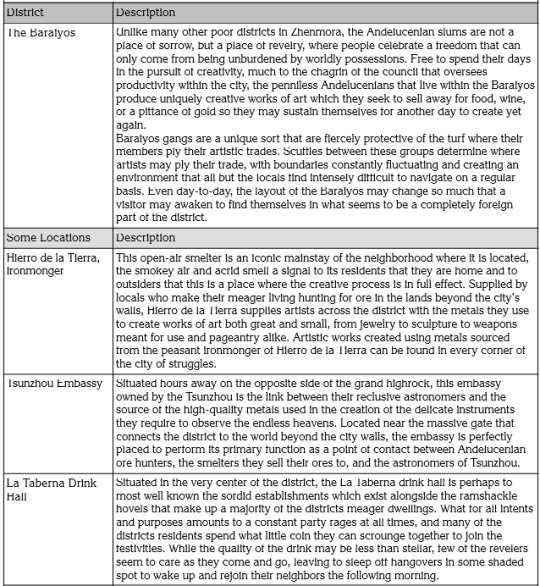
17 notes
·
View notes
Text
My overall thoughts on Immortal Hulk...
About a week ago, I finished marathoning Al Ewing's groundbreaking 50-issue run on Immortal Hulk. Overall, this series was a phenomenal psychological horror and character-defining analysis of Bruce Banner and the core concept of the Hulk!
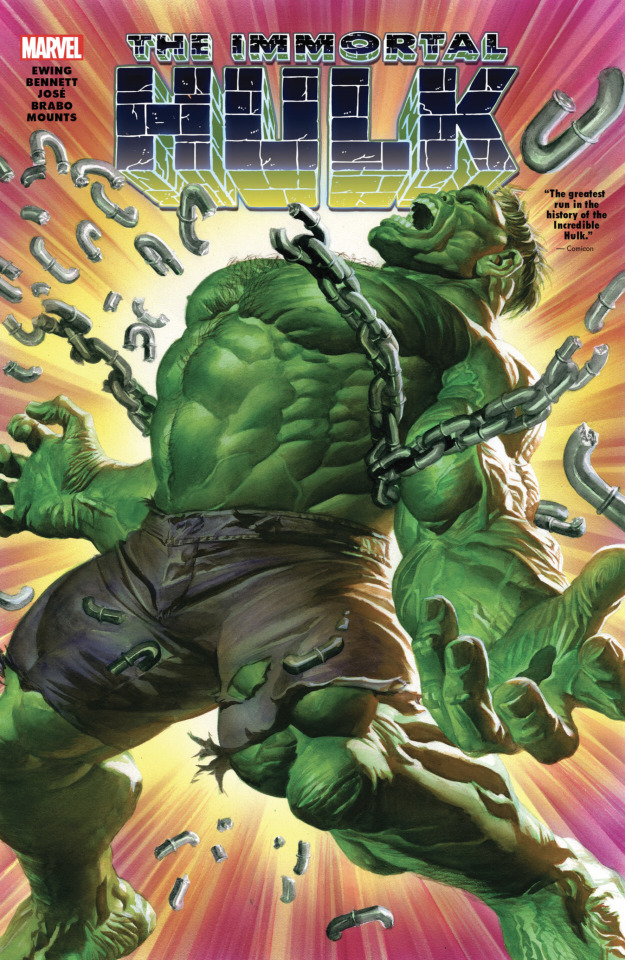
Immortal Hulk takes place after Marvel's Civil War II crossover event, wherein Bruce Banner was killed by Hawkeye after he personally requested the latter to shoot him with a specialized arrow. However, Bruce is not only mysteriously resurrected but discovers that every time he dies he is revived by his mysterious "Devil Hulk" persona, the most repressed and deadly of all of Bruce's multiple personalities.
I'm still processing my overall thoughts on the run after finishing its gargantuan omnibus collection, but what particularly resonated with me was the comic's thematic exploration about the concept of duality, and how seemingly diametrically opposing forces are, in reality, symbiotic to each other. Essentially, Ewing expands upon previous writers' foundations establishing the Hulk as a product of both the original Gamma Bomb explosion, as well as Bruce's deep-seated childhood trauma derived from his abusive father, Brian Banner. Throughout the series, Ewing draws influence from famed psychologist Carl Jung's theories regarding the "shadow," or the innermost repressed aspects of an individual's identity that are masked beneath the "persona," or how an individual presents themselves to the rest of society. Additionally, Ewing heavily references elements of both Gnostic & Kabbalist mysticism such as the Tree of Life, along with the idea of Hell as not a place but the absence of God, framing the Devil as God’s "shadow," whereas Satan (i.e. God’s fallen Angel of Judgement) is framed as both the "accuser" and the "adversary."
In large measure, Ewing brilliantly interweaves these psychological & mystical concepts into the mythos of the Hulk, recontextualizing the Green Goliath as the “Devil” to Bruce’s creator or “God" (i.e. his abusive father), but that gamma radiation has a mystical third quality to it that allows access to the Jungian shadow world, the opposite end of the Kabbahlist Tree of Life representing God’s crown (i.e. the Hell beneath all other Hells, the realm of "The One Below All"). And that Bruce's "Satan," aka his feared "Devil Hulk" persona, actually has the potential to be a positive force. Through his immortal rage, the Hulk evolves from a mere destructive monster into a revolutionary "accuser" passing judgement upon the Hell that humanity has created on Earth. An "adversary" whose left hand invokes destruction upon societal injustices like capitalism and bigotry, but whose right hand provides mercy to innocent victims like the child that once existed within the Hulk.



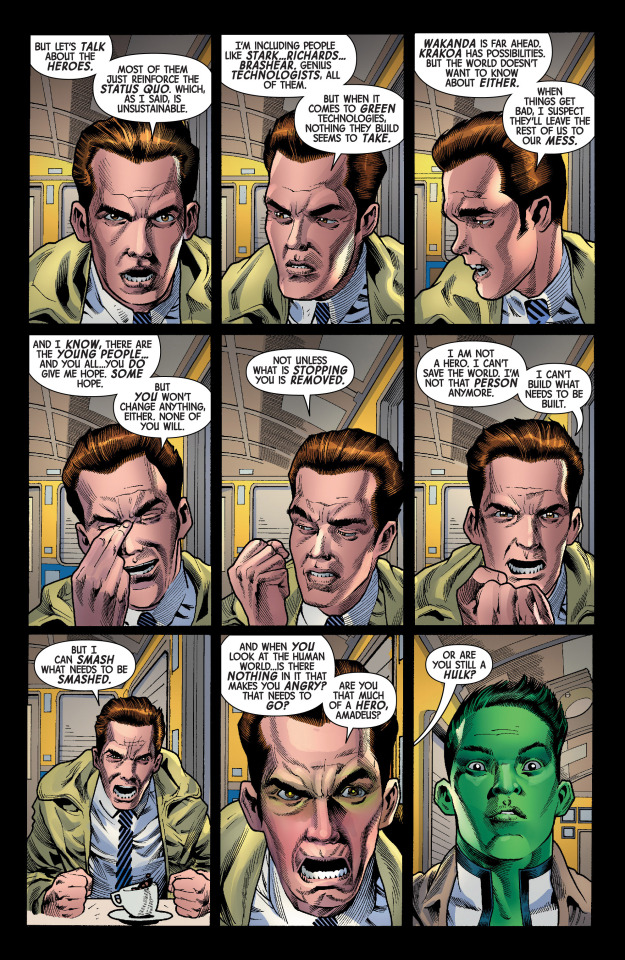
As a leftist with a Master's Degree in History of Ideas, I found Immortal Hulk's thematic emphasis on Jungian & Kabbalistic philosophy to be incredibly captivating & thought-provoking (it also greatly appealed to me as a humongous fan of both Neon Genesis Evangelion anime series + movies and the Persona games)! Furthermore, Ewing establishes the series' overtly progressive tone by not only featuring military & corporate figures such as General Fortean & Dario Agger as major secondary antagonists (with the series’ main antagonists being the aforementioned Brian Banner, as well as The Leader), but also through utilizing supporting characters like Jackie McGee & Dr. Charlene McGowan to provide humanizing portrayals of both Black and trans women respectively (while also meaningfully analyzing the forms of systemic issues that both marginalized groups experience).

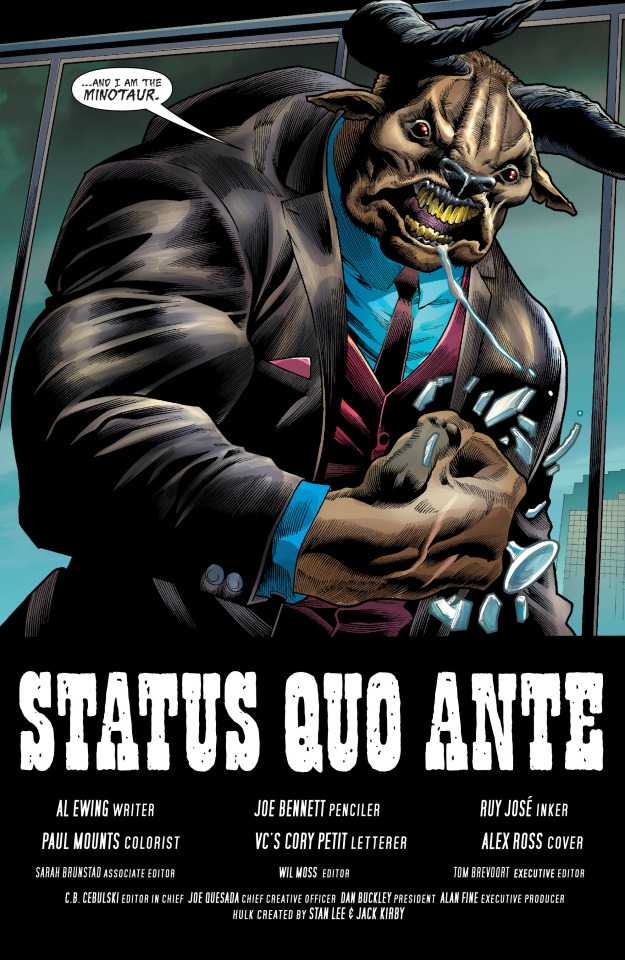
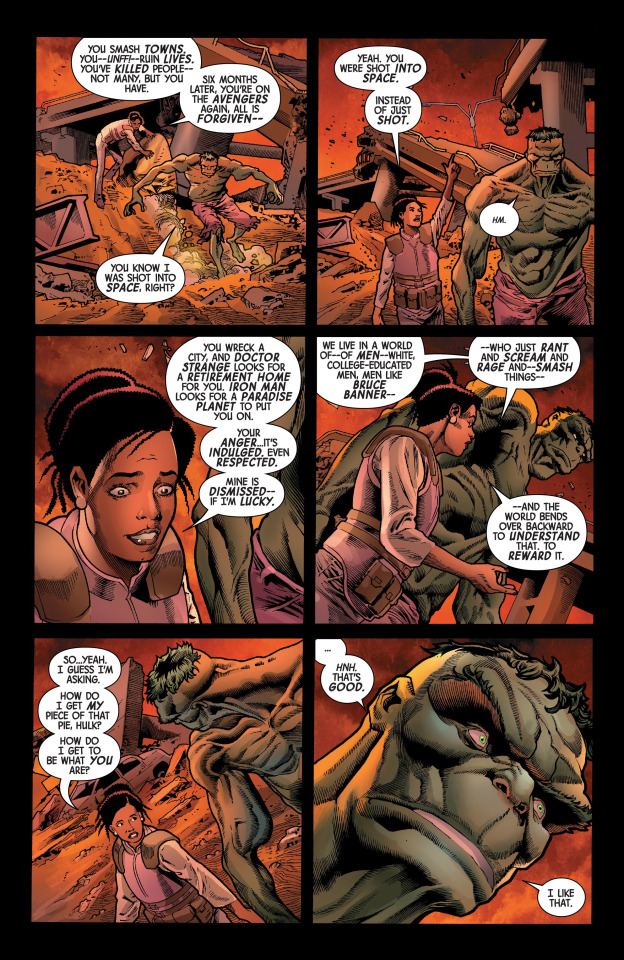

Honestly, the fact that Ewing wrote such positive racial & queer representation sadly made it even more shocking when the book’s lead illustrator, the now disgraced Joe Bennett, was revealed to be a massively bigoted scumbag in 2021, when fans unearthed an old 2017 FaceBook post of Bennett’s that featured horrifically antisemitic artwork of his. Fortunately, this resulted in Bennett not only being fired by Marvel, but Ewing publicly denouncing him.
So yeah… while the artwork in Immortal Hulk is incredibly solid & effective in regards to the series' emphasis on physical & psychological horror… sincerely, screw Joe Bennett!
Overall though, I immensely enjoyed Immortal Hulk and I can definitely see why this series is heralded as the magnum opus of all Hulk runs!
#hulk#immortal hulk#bruce banner#devil hulk#incredible hulk#philosophy#theology#carl jung#gnosticism#kabbalah#black lives matter#trans rights are human rights#brian banner#jackie mcgee#charlene mcgowan#reginald fortean#dario agger#comic review#al ewing#screw joe bennett#marvel comics
18 notes
·
View notes
Note
I have to make one correction. Kalim's father IS a part of the political system in that country. During the Scalding Sands event Jamil flat out says, "Kalim's father is a KEY PLAYER in our country's government and politics." Saying his father is just a wealthy merchant is factually wrong.
So I wanted to let you know, I went and looked this up and you are correct. Kalim's father is mentioned by Jamil as a Key Player, ( I wasn't sure if this was in the Japanese or English version), but I'm also correct as he is known mostly for being a famous merchant. So we're both right. ^_^ The thing is that I found some interesting aspects too re looking over the Scalding Sands. It mentions that there are other well known and wealthy families that have influence in the country. This is noted when Jamil mentions that other families take turns in hosting the event, and this year it's the Asim family's turn.
It very much sounds less like he's a direct political person, and more of an influential figure, more of a George Clooney or Bill Gates than a Caroline Kennedy. The reason I make this difference is that in the cases of these people, George Clooney has influence in certain aspects, ex: His wife's role in regard to Human Rights as a Lawyer, but he's more well known as an actor, producer and director. Bill Gates has the foundation, but more people know of him as the head of Microsoft (even though he's stepped away from that for years). Where as Caroline Kennedy is known as an Ambassador and the daughter of a late president. For most people this would mean to them that Caroline would have more direct political influence and be a larger Key player due to whom her father was and her role directly in the political system itself.
Where as George or Bill would be more, off the side, and indirect in their role, which is how I see Kalim's father. While he probably helps with the lobbying for certain laws, he undeniably is more known internationally and probably locally, for his family's past actions.
Other thing of note was what Malleus said, it implied that there was, at some point, civil unrest in the Scalding Sands. How much of that was fixed by the Asim's I don't know. But it makes me want to learn more about the history.
#kuroshitsuji#black butler#disney#twisted wonderland#asked and answered#scalding sands#kalim al asim
10 notes
·
View notes
Text
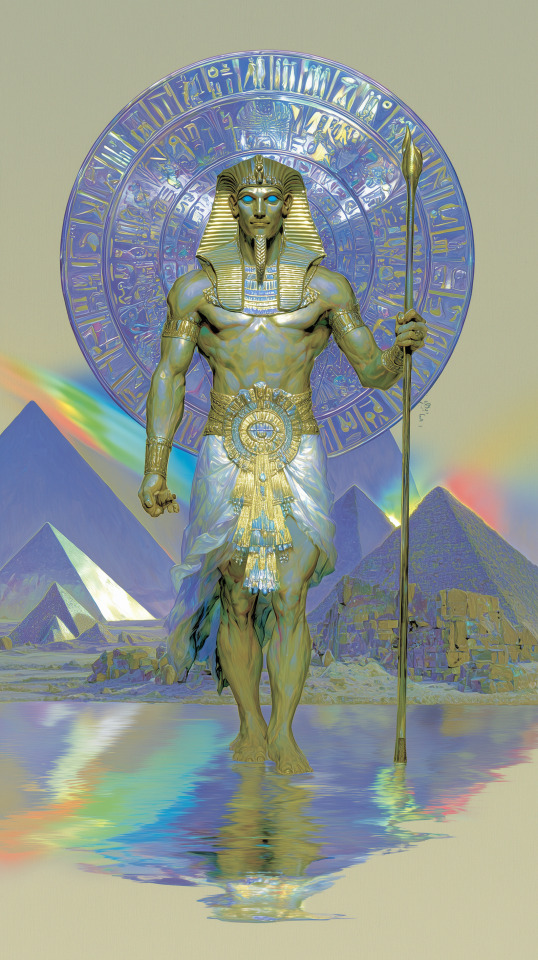
“And the Spirit of God moved upon the face of the waters”
(Gen. 1:2).
Alpha and Omega Talon Abraxas
The Cosmic Beings Alpha and Omega: Guardians of the Universe
Throughout human history, we have marveled at the mysteries of the cosmos, pondering the existence of powerful entities that govern the fabric of reality itself. Among these enigmatic beings are Alpha and Omega, two cosmic entities shrouded in divine significance. Representing the beginning and the end, these celestial beings have captured the imagination of countless civilizations across the cosmos. Let us delve into the depths of their existence and explore the roles they play in the grand tapestry of the universe.
Alpha, the Primordial Force:
Alpha, often depicted as a radiant figure engulfed in brilliant light, personifies the cosmic force responsible for the creation and birth of all things. As the embodiment of the initial spark of existence, Alpha is associated with creation, growth, and the birth of stars, galaxies, and life forms. Many cultures have revered Alpha as the supreme deity, the architect of the cosmos.
In various mythologies, Alpha is often associated with concepts like light, purity, and divine order. It is believed that Alpha’s influence can be seen in the harmonious patterns found in nature, the symmetrical formations of celestial bodies, and the intricate structures of living organisms. Alpha is the driving force behind the evolution and progression of the universe, guiding the unfolding of cosmic events.
Omega, the Ultimate Destination:
Omega, the counterpart of Alpha, represents the force of ultimate destiny and the end of all things. Portrayed as a figure cloaked in darkness, Omega embodies the cosmic power responsible for the dissolution, transformation, and eventual conclusion of all existence. Just as Alpha marks the beginning, Omega marks the inevitable end of cosmic cycles.
In many belief systems, Omega is associated with concepts like death, rebirth, and transformation. It is believed that Omega’s influence can be observed in the decay of stars, the collapse of civilizations, and the eventual dissipation of energy across the cosmos. Omega serves as a reminder that all things are subject to change and impermanence.
The Interplay of Alpha and Omega:
The interplay between Alpha and Omega forms the foundational rhythm of existence. They are inextricably linked, locked in a perpetual dance of creation and destruction, birth and death. The dynamic equilibrium between these cosmic beings maintains the delicate balance of the universe.
It is important to understand that Alpha and Omega do not represent opposing forces in a dualistic sense but rather complementary aspects of a greater whole. The harmonious interdependence between creation and destruction is what allows the universe to continuously evolve and transform.
Alpha and Omega in Human Consciousness:
The concepts of Alpha and Omega extend beyond the realms of mythology and theology; they resonate deeply within the human psyche. We find ourselves pondering the mysteries of our own existence, searching for meaning, purpose, and a sense of direction. Alpha represents our longing for new beginnings, growth, and the pursuit of knowledge, while Omega reminds us of the transient nature of life and the inevitability of change.
In our quest for understanding, we often look to the cosmos for guidance and inspiration. The awe-inspiring beauty of the night sky, the grandeur of galaxies, and the intricate dance of celestial bodies evoke a sense of wonder and humility. Contemplating the vastness of the universe can remind us of the interconnectedness of all things and our place within the cosmic order.
And always remember that “as above, so below.” The grandeur of the universe, of cosmos, that macrocosmic beauty is reflected within us as the microcosmic design of the human body as an extension of the greater design.
Conclusion:
Alpha and Omega, the cosmic beings representing the beginning and the end, are archetypes that transcend time and space. They symbolize the eternal cycle of creation and destruction, birth and death, and serve as a reminder of the transient nature of existence. Whether as mythical deities, spiritual concepts, or cosmic principles, Alpha and Omega have captivated the human imagination, offering a glimpse into the profound mysteries of the universe. In our ongoing journey of discovery, may we continue to seek harmony with these celestial forces, striving to understand our place in the vast cosmic symphony.
20 notes
·
View notes
Text
Humans are weird: Civil Unrest
( Please come see me on my new patreon and support me for early access to stories and personal story requests :D https://www.patreon.com/NiqhtLord Every bit helps)
History books often talk about important events through the eyes of those with hindsight. Written in ways that make readers question how the people who actually lived through the events themselves ask how they could not have seen it coming from a mile away.
Yet for those who lived through such trying times the sequence of events were never so neat and orderly as “Point A” and “Point B”. They came on like a silent wave that could not be heard until it crashed against the foundation of society and tore everything it struck down into the dirt.
One such point of history was the day the Pentarki people experienced their first case of civil unrest.
For context in Pentarki society when a judicial ruling is handed down it could not be altered. There were no challenges, no reviews of inquiry, or appeal process to a higher form of political body for a different ruling. The end result was set in stone and there would be no argument. While strange to other space traveling societies who had several checks and balances for Pentarki it made complete sense.
To obtain a position in the judicial branches of society a Pentarki needed to be highly intelligent, well versed in social laws and history, and have some aspect of a moral code. It was through these foundation blocks that a near incorruptible governing body was created to hand out rulings for criminal cases.
The Pentarki had spent generations under this type of organization and whole heartedly believed that the process was secure; never questioning a ruling or lashing out in outrage.
That was until the day humans began migrating to their world.
Being one of the most adaptable species in the known universe, humans had a knack for setting up shop on just about any planet they came into contact with. On the Pentarki homeworld they found that despite the lethal levels of gases encircling the planet it was on average warmer than any other planet resulting in a steady stream of humans in search of said warmth.
Humans in contrast to Pentarki’s had a very different perspective of organized governing. They believed that laws and people could make mistakes and if needed, could be altered to reflect the current nature of the times. This alone was enough to ensure the Pentarki avoided dealings with humans as much as possible; at least until the “Night of ten thousand Fists.”
In a standard ruling, the governing body decided in the case of a little Pentarki child getting injured by a Pentarki enforcement officer that the officer was not at fault. Situations like this were rare but not unheard of and the enforcement officers were almost never marked for fault. While the Pentarki people had expected as much, they had not taken into account the overly passionate nature of the new human citizens who had moved to the planet.
Within hours of the ruling there were large scale protests in the streets, primarily composed of humans. They held signs and chanted dissenting slogans against the governing body that made the ruling. Enforcement officers were dispatched to try and contain the protests, but their presence only seemed to further enflamed the protestor’s anger. Pentarki enforcement officers were not trained for this type of civil disturbance as protests were all but unheard of in their culture. In an attempt to disperse the crowd the officers attempted to arrest the ringleaders who were using megaphones to rile the crowds. This backfired as the humans became further violent and began attacking the enforcers. They swarmed them from all sides and the officers were quickly consumed by a tide of human bodies.
From there things devolved rapidly as the protests turned into full blown riots. Any symbol of authority was defaced or destroyed while enforcing officers were targeted on site. Store fronts were destroyed, monuments defaced, and public destruction in general skyrocketed as several cities became consumed by anarchy. It took a full fifteen hours before order was finally restored and only then as a once in a lifetime reversal of the ruling was issued.
This action shook the Pentarki society to its core. Through open violence a ruling had been changed for the first time in their people’s history. There was open resentment towards the humans who many viewed as shoehorning their own beliefs into society, but there was also a newfound sense of disappointment of the ruling body as they were now seen as not as stalwart as they once were.
From that moment onwards many worlds were far more hesitant with allowing humans to settle on them in great numbers.
#humans are insane#humans are weird#humans are space oddities#humans are space orcs#scifi#story#writing#original writing#niqhtlord01
66 notes
·
View notes
Text
Lucifer The Trickster
Daemon Barzai
“Among different masks and guises of Lucifer, without a doubt, the Trickster is one of the most attractive. This aspect of Lucifer has a close relationship with men, their needs and desires. It is easy to find him in everyday life. He enjoys the company of humans. But this aspect of Lucifer not always answers the magician’s calling. His nature is changeable, ambiguous, and, above all, tricky. Those who are looking for him, can find him at the crossroads in the middle of the night or in wild forests. Lucifer always tests the magician who summons him. We can find evidence of this in many legends and stories. In classical grimoires, we found detailed descriptions of a pact between a magician and Lucifer. The magician wishes for wealth but in exchange he sells his immortal soul, and 20 years later the magician becomes the devil’s slave.
If we analyze this legend, the message is simple, Lucifer puts the magician through ordeals and tests. With this aspect of Lucifer, hardly anything is for free and everything has a price. An ambitious magician may pay with his own life after a period of material wealth and pleasures. But above all, the magician should bear in mind that there are always tests and ordeals. If the magician is able to pass the tests, he will find real wealth, which is waiting not on the material plane, but on the spiritual.
It is interesting to see how this mask of Lucifer is present in different cultures. In Argentina, there is a secret cult/form of dark witchcraft known as “El Legado de San Diablo” (The Legacy of Saint Devil). This legacy works with the folklore aspect of Lucifer. In this cult, the aspirant should summon Lucifer at the crossroads, in a solitary place, alone in the middle of the night and make a pact with him. But first, the magician should pass all kinds of tests, and if he passes them he will gain a powerful ally.
The Legacy of Saint Devil is a very dark form of witchcraft. It has a foundation in the native folk tradition. It is easy to see that “Saint Devil” is a pejorative name which reflects the antinomian nature of this form of witchcraft. In the Legacy, it is Lucifer that teaches the secrets of the cult.
In another Argentinean legend Lucifer appears in a native story called Salamanca. According to the legend, on special and magical nights a secret cave opens its doors in the middle of wilderness, where nature is untamed and there is no civilization. The legend has it that the cave opens its doors for those who look for Lucifer. But one more time, the person has to pass all kinds of tests and ordeals. These tests are about rationality. The person can sell one's soul in exchange for knowledge or whatever he/she wants. In this legend, Lucifer appears as half-human half-animal with a tail, horns and a devilish face. Also, he can appear as a Black Man, like in descriptions of old legends of witchcraft.
Another legend speaks of Saint John’s Night. A person who wishes to make a pact with Lucifer should go alone, at midnight, under a fig tree and call Lucifer with pure will and without fear. The fig tree has only one flower. The magician has to “grasp” this flower and Lucifer will appear ready to make a pact.
All these legends have one thing in common—Lucifer is a tricky and wise spirit. He enjoys the company of men. And also, he enjoys tempting man with mundane riches but then he comes back to demand payment for his favors. The lesson here is simple, Lucifer has a great power, he can give the magician whatever he wants, power, money, etc. But first, the magician should dare to make a pact with him. However, bear in mind that the true wealth is not in material things but in the spiritual world. This is the secret of a successful pact with Lucifer. This does not mean that you cannot achieve wealth or power, but all this should have a proper balance between both realms. Also, it is important that Lucifer always asks something in exchange for his favors. He can be a powerful ally and the best teacher, but you need to know how to negotiate with him...”
#luciferian witch#luciferism#luciferian#lucifer#lucifer devotee#theistic luciferianism#lucifer deity#lord lucifer#pagan#witchcraft#paganism#demonology#demonolatry#grimoire
20 notes
·
View notes
Text
Survey: Who is your favorite mathematician from the French Revolution among this group?
These individuals contributed to mathematics during the Revolution, or used this field to better support or contribute to the Revolution.
Here are a few I’ve selected (a brief introduction even though we all know them, or almost)
Lazare Carnot:
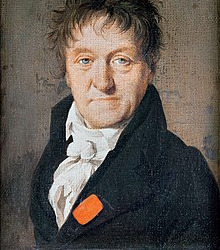
Before the Revolution, he was a captain in the Corps of Engineers and had completed brilliant scientific studies. Elected as a deputy for Pas-de-Calais along with his brother, he immediately focused on military matters before his appointment to the Committee of Public Safety, where he oversaw the conduct of the war, both in Paris and on the battlefield. Upon his re-election after the fall of the monarchy, he voted for the king’s execution without delay and supported the proposal for public assistance, among other initiatives. He also collaborated with Condorcet, Pastoret, and Guilloud on women’s education. Despite his revolutionary activities, Carnot continued to write on mathematics, including his "Réflexions sur la métaphysique du calcul infinitésimal ", written in 1790 (first edition published in 1797). So, even during the Revolution, he did not forget mathematics.
Nicolas de Condorcet:

Here is the revolutionary defender of gender equality that everyone anticipated. Born a noble, he became a revolutionary and engaged early on with progressive ideas, whether scientific or political. He advocated for the rights of Black people, equal rights, and gender equality. He was critical of the Declaration of the Rights of Man and Citizen and the Constitution of 1791, which he found too moderate. Elected to the Paris Commune and later as a deputy, he held republican views and proposed a public education plan that laid the foundation for the school system envisioned under the Third Republic. Strongly opposed to the death penalty, he suggested condemning Louis XVI to hard labor instead. Condorcet also made contributions to mathematics. While in hiding, following his wife Sophie de Grouchy's advice, he wrote a mathematical work titled "Esquisse", which was published posthumously by his widow and traced the general progress of the human spirit across political and scientific history. He also passed notes to his wife for his "Éléments d'Arithmétique et de Géométrie", a two-part book for teachers and students.
Prieur de la Côte-d'Or:

After brilliant scientific studies in Dijon and Paris, he joined the Jacobin Club in 1790 and even presided over it during Louis XVI's flight. Elected to the Legislative Assembly, he opposed the royal veto and supported measures such as the decrees against émigrés and refractory priests, as well as the call for volunteers in 1792, while working on various committees, especially the education committee. After the fall of the monarchy, he was sent to eastern France with Carnot to reorganize civil and military authorities in an urgent context. Often dispatched on military-related missions throughout France, he joined the Committee of Public Safety. As a scientist and mathematician, he was particularly useful to the Revolution, notably in technical aspects like troop supply, weapons innovations, and the creation of military schools. After leaving the Committee, he joined the Education Committee, where he contributed to the creation of elite schools and the development of the metric system.
Gaspard Monge:
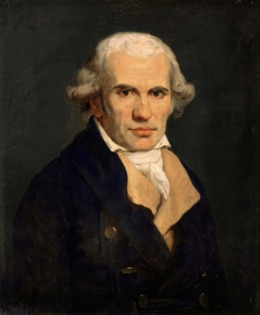
One of the main architects of the 19th-century mathematical revival, he was also a professor and friend of Lazare Carnot. Monge entered politics in 1790 and was an enthusiastic member of the Jacobin Club. He served as Minister of the Navy from August 1792 until 1793, tasked by the Committee of Public Safety with the procurement of arms, ammunition, and clothing for the army. He succeeded in significantly increasing the production of bronze cannons and rifles, among other resources, finding ways to secure saltpeter and other materials that were hard to obtain during the war with neighboring countries. Monge also contributed to the establishment of École Polytechnique and served as its director. One of his most important works is "Feuilles d'analyse appliquée à la géométrie", published in 1795. He was a professor at the École Normale, created in 1793, and was appointed a member of the Institut de France in 1795.
Charles-Gilbert Romme

Lastly, one of the last Montagnards, often called "the Crêtois." He also pursued brilliant studies, excelling in mathematics . He welcomed the French Revolution with enthusiasm and was one of the few deputies advocating for more civic rights for women, co-founding with Théroigne de Méricourt the mixed-gender Club des Amis de la Loi. Elected as a deputy to the Legislative Assembly, he supported the war effort. Later re-elected, he initially sat with the Plain before permanently joining the Mountain, where he voted for the king’s execution without delay and opposed Marat’s prosecution. He was sent on several missions for the Convention, including one to Caen, where he was imprisoned. Romme joined the Hébertists in supporting de-Christianization, endorsing the Cult of Reason and the de-priesting of Gobel. However, he did not witness the executions of the Dantonists, Hébertists, or the events of 9 Thermidor as he was on a mission that began in February 1794 and ended in September 1794. He remained faithful to his beliefs, even in 1795 when the liberalization of the economy worsened poverty, and the Convention took a more right-wing turn. He supported the 1st Prairial insurrection. Regarding mathematics, Romme was one of the creators of the Republican Calendar. His mathematical skills were vital in its design, as it adhered to the decimal system.
Sources:
Antoine Resche
Jacqueline Feldman
Le bicentenaire de Gaspard Monge ( article) write by Sergescu
#frev#french revolution#poll#lazare carnot#claude antoine prieur#monge gaspard#Romme Charles Gilbert#condorcet
18 notes
·
View notes
Text
ᯓᡣ𐭩Vampiresᯓᡣ𐭩

(id just like to say i love vampires and grew up in love with g1 draculaura from monster high :3)

For centuries, vampires have fascinated the human mind, appearing in various forms across different cultures and periods. From ancient legends to modern pop culture, these mysterious beings embody themes of immortality, fear, desire, and power.
Origins and Historical Context
The idea of the vampire dates back to ancient civilizations, with early mentions in Mesopotamian, Greek, and Roman mythology. These early "vampiric" figures were often demons or spirits linked to death and the underworld. For example, the Mesopotamian myth of Lilith describes a demoness who preys on infants and seduces men, echoing later vampire tales.
In Slavic folklore, the vampire was a more tangible figure—a reanimated corpse that rose from the grave to drink the blood of the living. These beliefs were often connected to unexplained deaths and diseases, and methods to prevent or eliminate a vampire included staking the body, decapitation, and burial rituals designed to keep the dead at rest. The "upir" in Russia and "vrykolakas" in Greece are examples of these regional variations.
Fear of vampires led to widespread practices aimed at preventing vampirism, such as burying bodies with objects believed to restrain the undead or placing garlic around homes to ward off these nocturnal predators.
However, these legends often arose from a misunderstanding of how bodies decompose. As a corpse’s skin shrinks, its teeth and fingernails can appear to have grown longer. And as internal organs break down, a dark “purge fluid” can leak out of the nose and mouth. People unfamiliar with this process would interpret this fluid to be blood and suspect that the corpse had been drinking it from the living. To which they would rip out hearts of the dead bodies and then feed it to their families.
Literary Vampires: Folklore and Fiction
Vampires entered the literary spotlight with John Polidori's "The Vampyre" in 1819. Inspired by a fragment written by Lord Byron, this short story introduced the aristocratic vampire, a sophisticated and charismatic predator. Polidori's work laid the foundation for later vampire literature, including James Malcolm Rymer's serialized novel "Varney the Vampire" (1845-47), which further established the vampire's place in popular culture.
The quintessential vampire novel, Bram Stoker's "Dracula" (1897), further popularized the vampire archetype. Stoker's Count Dracula, a mysterious and menacing nobleman from Transylvania, became the model for many future depictions. "Dracula" combined elements of Gothic horror, romance, and adventure, captivating readers and securing the vampire's place in literary history. The novel also mirrored Victorian anxieties about sexuality, immigration, and the breakdown of traditional social structures.
Vampires in Modern Culture
The 20th and 21st centuries have seen a surge of vampire-themed media, reflecting society's changing fears and interests. Early film adaptations, such as F.W. Murnau's "Nosferatu" (1922) and Tod Browning's "Dracula" (1931), brought vampires to the big screen, creating lasting images. "Nosferatu," with its depiction of Count Orlok, emphasized the monstrous and terrifying aspects of the vampire, while Bela Lugosi's portrayal of Count Dracula in Browning's film brought a suave and sophisticated allure to the character.
In the latter half of the 20th century, Anne Rice's "The Vampire Chronicles" series redefined the genre, presenting vampires as deeply introspective and morally complex beings. Rice's portrayal emphasized the emotional and existential dilemmas faced by immortals, resonating with modern audiences. Her characters, like Lestat and Louis, grapple with themes of identity, guilt, and the search for meaning in an eternal existence.
The late 20th and early 21st centuries witnessed a rise in vampire popularity, particularly in television and film. Series like "Buffy the Vampire Slayer" and "The Vampire Diaries," along with the "Twilight" saga, reimagined vampires as youthful, attractive figures entangled in romantic and often tragic narratives. These works expanded the vampire mythos, appealing to a broader and younger demographic. "Buffy," for instance, juxtaposed the supernatural with everyday high school struggles, using vampires as metaphors for personal and societal issues.
(id also like to recommend a show im loving atm called what we do in the shadows its so good)
Themes and Symbolism
Vampires serve as versatile symbols in literature and media, embodying various themes and societal anxieties.
Vampires, as undead beings, blur the line between life and death, exploring humanity's fear of mortality and the desire for eternal life. This theme is evident in works like "Interview with the Vampire," where characters wrestle with the implications of living forever.
Vampires often represent the outsider, reflecting societal fears of the unknown and the marginalised. The vampire's need to hide their true nature parallels the experience of those who feel alienated or persecuted in society.
The act of vampirism, often depicted as a form of seduction, symbolises taboo desires and the complexities of human sexuality. This is evident in the sensual imagery associated with vampire bites and the intimate connection between predator and prey.
Vampires, with their supernatural abilities, frequently serve as metaphors for power, control, and the corrupting influence of absolute power. Dracula's control over his victims and his manipulation of others reflect the dangers of unchecked authority.
Vampires remain a potent and adaptable myth, continually evolving to reflect contemporary cultural and psychological landscapes. Whether as monstrous villains or tragic anti-heroes, vampires captivate audiences by embodying timeless human fears and desires. Their enduring appeal lies in their ability to mirror our deepest anxieties while offering a glimpse into the tantalizing possibility of life beyond death. The vampire's journey from ancient myth to modern icon underscores their significance in our collective imagination, ensuring that they will continue to haunt our stories and dreams for generations to come.

#history#dark aesthetic#dark academia#goth#goth aesthetic#gothcore#gothic aesthetic#vampire aesthetic#interview with the vampire#buffy the vampire slayer#the vampire diaries#the vampire chronicles#vampcore#vampires#dracula#bram stoker#twilight#anne rice#nosferatu#tod browning#bella lugosi#the vampyre#john polidori#literature#gothic#gothic literature#varney the vampire#draculuara
34 notes
·
View notes